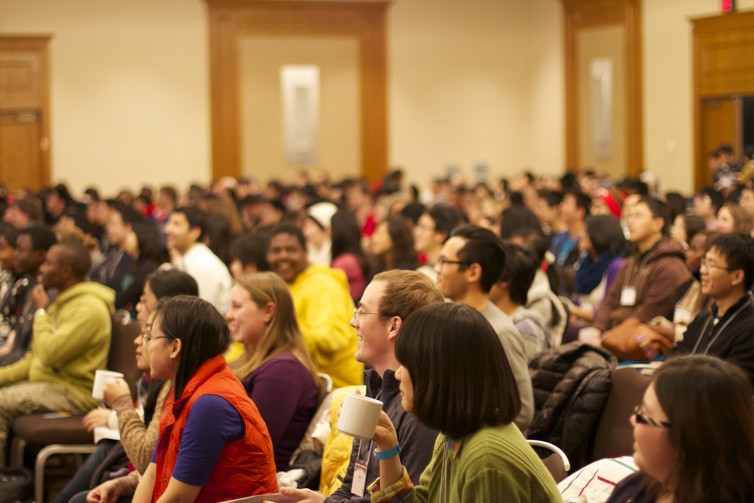Diversity in Higher Education: The Issues Most People Don’t Think About

Colleges used to be for the elites only…but now student bodies are no longer composed of primarily male, white students. Some estimates show that half of America’s current workforce now passes through college first and 75 percent of students in high school spend at least some time studying in a higher education setting. That number is up from an elite four percent in 1900. What’s more – the number of college students from low-income and minority families continues to rise. When it comes to diversity in higher education, in this article, we will talk about the issues that most people don’t think about.
Of course, the increased diversity of student bodies comes with its own quirks. Read on and find out:
- What’s helping so many more students go to school
- Why men and Asian Americans might get the short end of the stick
- The shocking fact about faculty in higher education
Two tools that are changing the face of higher education
Young people who choose to pursue more education after high school are often encouraged by the idea of more attractive career prospects. However, let’s be honest. College can have a hefty price tag. This is enough to keep many from attending.
Fortunately, however, there are ways to get around the fact that college (and other post-secondary training programs) is just plain expensive. Let’s just talk about two.
First, there are online courses. Each year online learning becomes less of a fringe movement and more mainstream. More than 6.7 million people took at least one online class in the fall of 2011 and 32 percent of college students now take at least one online course during their matriculation. It is even becoming common for high schools to require all students to take an online class before graduation as a way to prep them for the “real world” of secondary education.
Online learning is flexible and convenient. This is well-known. But less discussed is the way distance education promotes diversity of the college population. With less red tape than the traditional college format, online students are able to earn credits while still working full time, maintaining families and dealing with illnesses. Whether students take just one course remotely, or obtain an entire degree, they are able to take on the demands of college life more readily – leading to student populations with more variety.
The Babson Survey Research Group recently revealed that while online college student enrollment is on the rise, traditional colleges and universities saw their first drop in enrollment in the ten years the survey has been conducted. This drop is small – less than a tenth of one percent – but its significance is big. A trend toward the educational equality of online curriculum is being realized by students, institutions and employers across the board. The benefits of a college education are more accessible to students that simply cannot commit to the constraints of a traditional campus setting.
A controversial experiment that could lead the way to even more college credit accessibility is MOOCs, or massive open online courses. As the name implies, these classes are offered to the general public at a low cost, or no cost, in the hopes of earning their students college credit. California-based online course provider Coursera recently had five of its offerings evaluated by the American Council on Education for college credit validity. Four of the courses were recommended for college credit by ACE, and one was endorsed for vocational credit, providing student work verification through a strict proctoring process.
These credits are not earned through community colleges or online-institutions; Duke University, the University of California at Irvine and the University of Pennsylvania are on Coursera’s list of places the courses will earn credit for students that pay a nominal fee. Students that obtain these credits through Coursera can approach any higher education institution and seek their inclusion in a degree program, but the final discretion is up to the particular school.
MOOCs are certainly in an infancy stage and do not provide a “sure thing” yet for students that participate. In the Babson survey mentioned earlier, only 2.6 percent of schools offer a MOOC, but an additional 9.4 percent are building a MOOC plan. This form of online learning means that students do not have to commit to an entire course of study to receive credits. They don’t even have to commit to a particular institution upfront.
MOOCs will further eliminate the socio-economic barriers that keep promising students from seeking out college credits. Students are given more flexibility in scheduling at an affordable price. Though the MOOC trend has its dissenters, I believe it will win over even the most skeptical and increase accessibility for all people that seek higher education. After all, at one time the mention of online courses raised a few eyebrows in the educational community and look how far the concept has come. Further development of online initiatives, specifically in the area of MOOCs, represents the next big step for enriching the diversity of the college student population in America.
Another option that makes college more accessible, not quite so new and exotic as online courses, is community college.
According to Dr. Alicia Dowd, associate professor of Higher Education at the University of Southern California, about 7 million students are enrolled in community colleges. As she says, “[I]t’s not an overstatement to say that community colleges are an integral part of the national narrative in the United States about the ‘American Dream.’ Sandwiched between high school and four-year colleges and universities, they are an important rung in the ladder of our very stratified society and educational system.”
Community colleges are important to many students because of the increased opportunities for success provided by conveniences such as price, flexibility for those with busy work schedules, proximity, and accessibility for non-traditional students.
Promoting Diversity: Are men and Asian American students getting the short end of the stick?
That more women, underrepresented minorities, and low-income students have been attending college over the past several decades is rather encouraging.
But sometimes, in paying attention to certain groups, other groups are neglected. It’s worth looking at what this might mean.
If you have been following education hot button issues for any length of time, you’ve likely read about the nationwide push to better encourage girls in areas like science, technology, engineering and math (STEM). The thought is that by showing young women that these topics are just as appropriate for them as their male peers, more women will find lasting careers in these traditionally male-dominated fields.
I’m all for more women in the STEM workplace but with all this focus in one area, are educators neglecting an even larger gender gap issue?
Nationally, over 57 percent of college attendees are female when public and private school stats are combined. Females have been consistently edging ahead of their male classmates since the late 1970s when the percentages flip-flopped. Aside from all-female schools, there are others that have marked disproportionate numbers. Pacific Oaks College in Pasadena has nearly 96 percent females in attendance, and the University of Tennessee Health Sciences Center in Memphis has over 93 percent.
There are a few reasons why more young women than men are choosing a college education. The first is that there are more trades that do not require a college degree that appeal to men. The second is that economically speaking, women earn a better living with a college degree than without one in comparison to men. Though there is still a wage gap (in 2012, women earned just 80.9 percent of the salaries of their male counterparts), women see the value their earning potential can gain from achieving a college diploma.
I hear people asking this question all the time: What are K-12 educators doing wrong when it comes to preparing young women for STEM careers? It’s a valid one.
But based on the statistics I’ve listed here, shouldn’t we also be asking this question: What are K-12 educators doing when it comes to preparing young men for a college education?
It all comes down to the weight we assign to the worth of a college education. If a diploma is simply a way to earn more money over a lifetime, then perhaps men are doing the intelligent thing by launching into the workforce early and without student loan debt. That logic is flawed, however, when taking into account the fact that blue-collar jobs are declining in favor of white-collar ones. A young man making a lifelong career decision today simply cannot predict what educational demands will be placed on his field in another 10, 20 or 30 years.
Money aside, there are other pitfalls in a disproportionate number of men going to college. Statistics show that marriages where the couples have differing education levels more often end in divorce than couples with the same educational achievements. And even before divorce is an option, women who set college educational goals may not want to settle for men with less motivation – at least when it comes to academics. If this trend continues, social dynamics may be impacted.
And it’s not just men who might be left in the dust.
One complaint with the United States Department of Education and another lawsuit against Harvard University claims that Harvard, along with other elite universities, are levying unfair admission standards against Asian-Americans based on their race.
The groups, which consist of at least 60 coalitions, state that Asian-Americans are held to a higher standard because they have higher test scores and better “overall academic achievement” than other racial groups.
According to the Washington Post, the complaint with the Dept. of Education states that Asian-American students “have the lowest acceptance rates at Harvard University…despite having some of the highest test scores.”
The lawsuit, filed by Students for Fair Admissions, alleges that Harvard violated Title VI of the Civil Rights Act. That section bans prejudice based on “race, color, and national origin.” The group says that the discrimination happens at all Ivy League higher education institutions and that data suggests that Ivy League schools were being discriminatory based on the number of Asian-Americans applying to those schools, specifically Harvard, and “the number of Asians Harvard was admitting.”
A lot going on with both claims as they seem to be based on a sort of reverse discrimination. Asian-American students are seen as over achievers, and if the complaint alleging that their test scores are among the highest of student applicants, then the accusations are at least worth exploring.
Defining racial discrimination in case where minority students are claiming inequity because of academic achievement sounds almost outlandish. It may also be tough to prove without sound proof and stringent data.
But a case where any set of minorities feels left out of the possibility of attaining a post-secondary education due to their skin color or heritage will likely solicit strong reactions from those against any form of Affirmative Action and legal counsel from the accused institutions.
With this situation, the waters may be a little murky because Harvard is a private institution of higher education. Attempting to force the rationale of adding diversity for the sake of variety may not work out so well. Harvard, for its part, has, of course, admitted Asian-American students and will continue to do.
The question is are they admitting too little a number, and if so, is there a racial quota?
Either way, watching this play out shall be interesting because of the implications that it may have for other private schools and their admission policies.
The shocking truth about diversity in college faculty
As I mentioned before, college campuses are more diverse now than ever. Nearly 30 percent of undergraduate students around the nation are considered minorities. However, that diversity mainly happens in the student bodies of schools.
Diversity in college professors and faculty? That’s, unfortunately, not as common.
According to the National Center for Educational Statistics, only 16 percent of full-time professors at post-secondary institutions are minorities. That means that 84 percent of those in full-time professorships are white, 60 percent are men and 25 percent are white women.
Those numbers decrease slightly with faculty. 79 percent of the “instructional faculty” within this nation’s colleges and universities are white and just six percent are black.
Considering the hiring boom that many schools have experienced since the start of the 1990’s, it’s surprising that not many minorities were included in that growth.
“The Condition of Education: Characteristics of Post-secondary Faculty” shows that there was a 42 percent increase in the number of instructional faculty hired from 1991-2011. During that 20 year period, not many institutions hired minorities to fill their vacant positions.
Outside of ethnicity and growth, the study also found that the wage gender gap between men and women professors was well north of $16,000. Less than half of America’s private and non-private post-secondary institutions had tenure systems, faculty at for-profit colleges and universities make far less than those at non-profit schools, and less than 10 percent of all faculty within higher education are employed at for-profit institutions.
What’s striking is the gross under-representation of minority professors at America’s higher education schools. While many may be concentrated within Historically Black Colleges and Universities or schools who have a high number of black students, that percentage makes barely a dent in the overall number of black, Asian, Hispanic, American indigenous who may teach at America’s best schools of higher learning.
So what’s going on here?
Faculty positions are extremely competitive. Colleges and universities often value professors that have publishing ability, or a strong past of publication, over actual teaching methods. This is not to say that there are not women and minorities with high qualifications but rather to point out that sometimes sex and race are simply not part of the hiring equation. Facts and figures on a resume are tangible ways to show what a particular candidate can bring to the job. It is more difficult for higher education decision makers to gauge the benefit of a person’s background or life experience on the students that pay good money to learn at a particular institution.
And then sometimes there are biases that affect professors who do not fit the traditional mold—both before they are hired and after they have broken into the field. For example, a study published by Vanderbilt University found that black faculty members are not only wanted for intellectual purposes but to entertain as well. Apparently being an expert in a field is not enough; these professors must step it up to pass the general public’s test for being a “good” teacher.
“Black faculty members are expected to be ‘entertaining’ when presenting academic research to mostly white peers, according to a new Vanderbilt study.”
The survey shows that black academics are expected to tell jokes and keep their presentations loaded with levity.
It gets worse for black women who are academics.
“Black females additionally noted being subject to their colleagues’ preoccupation with their clothing choices and hairstyle, and reported being admonished to play down their ‘passion’ and ‘smile more.’”
Many black men and women face these issues in the workforce in general—but they are amplified in higher education, where African Americans represent only nine percent of the field.
One of the authors of the study, Ebony McGee, is hopeful that the study will be used as a way to potentially train others in accepting workplace diversity.
“Our hope is that this study will offer novel and useful insights to those who organize presentations and those who give them, so they will be able to understand, appreciate and provide an improved experience for black and other minoritized scholars.”
Here’s the good news
Many colleges are stepping up their diverse hiring game. Schools like the University of California, Harvard and the University of Washington both study faculty diversity issues and try to piece together the most well-represented group of educators possible. Even Historically Black Colleges and Universities are trying to bring in students and faculty members outside the traditional population, especially since the original mission of those schools has changed. Certainly there are strides being made, but in order to best serve each generation of college students, the push for faculty diversity needs to continue on an upward path.
Looking at the big picture, diversity in faculty should not only be sought out for the students’ advantage. The college legacy as a whole benefits when many different perspectives are represented. Yes, it is important to have diversity in student populations, but those groups are temporary college residents. Faculty members have the long-term ability to shape the campus culture and make it more in sync with the rest of the real world.
And even more good news: the newest wave of college presidents is ready to retire.
What does this mean? It means there’s a chance to introduce diversity in the highest ranks of higher education.
As the latest wave of college presidents looks towards retirement, the higher education community has the opportunity to promote a more diverse presidential core. The next five years will set the tone for college leadership at the highest level for the coming decades and really for the entire student population too.
Here are the facts:
- 61. Average age of college presidents in 2011.
• 92. Percentage of college presidents aged in the mid-50s to mid-70s.
• 14. Average number of years that retiring college presidents serve in the role.
• 40. Normal number of new college presidents in the American Association of State Colleges and Universities every year.
• 109. Actual number of new college presidents from April 2011 to August 2012.
• 6. Number of new college presidents this school year in the California State system alone.
• 13. Percentage of college presidents who are racial or ethnic minorities, as of 2012.
• 14. Percentage of college presidents who were racial or ethnic minorities in 2006.
• 26. Percentage of women college presidents.
What makes someone qualified to be a college president?
In the past, college presidents from other schools and college vice presidents have most often ascended the ranks to fill empty presidential seats. While this still happens about 19 and 25 percent of the time, respectively, other leaders like provosts and deans are increasingly being considered to fill the college president vacancies. Some schools even search outside the college community to find leaders from other industries that fit the bill. There is really no hiring formula that applies to all college president spots and a “qualified” candidate could feasibly jump several levels of hierarchy to claim the spot.
How to encourage diversity in presidential ranks:
The first step to building diversity at the highest college administrative level is simply recognizing the opportunity at hand. American institutions of higher education often consider how a diverse student, and even faculty, population should look but do not extend that to top-tier leadership roles. Colleges need to rethink that strategy. I believe the trickle-down diversity effect works well in college settings. Instead of starting with the largest group (students), start cultural change at the top of the pyramid. If a school has a well-balanced student population already in place, chances are that the faculty and administration reflect that fact too.
The next step is to actively include diversity in the search process. I’m not saying that white men with the right qualifications should be excluded from the running; I just mean that colleges with open president seats should make sure the short list of candidates has some variety in experience, ethnicity, sex and race. The Rooney Rule, established in 2003 by the NFL, mandates that at least one minority candidate be interviewed for all head coaching spots. I think colleges need to do that same with their academic leaders.
Those in lower to middle-level leadership roles in colleges that have presidential aspirations should get ready now. Make sure your name is associated with talks about the future of the college by getting yourself involved in the action. Get published. Envision yourself on the same plane as the college presidents that went before you but realize that you have a unique voice to lend to the college community you want to lead. Embrace the turning tides. Be an active part of the changes in college administration and you will in turn be part of the progress.
For the rest of us, who are not in leadership roles in colleges, but who want to see more diversity in professors and college presidents, now is the time to push for change, and to bring awareness to the lack of diversity in higher education faculty.





